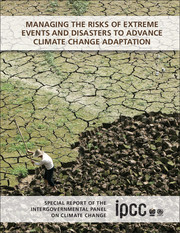 Managing the Risks of Extreme Events and Disasters to Advance Climate Change Adaptation
Managing the Risks of Extreme Events and Disasters to Advance Climate Change Adaptation Book contents
- Frontmatter
- Contents
- Section I
- Section II
- Section III
- Chapter 1 Climate Change: New Dimensions in Disaster Risk, Exposure, Vulnerability, and Resilience
- Chapter 2 Determinants of Risk: Exposure and Vulnerability
- Chapter 3 Changes in Climate Extremes and their Impacts on the Natural Physical Environment
- Chapter 4 Changes in Impacts of Climate Extremes: Human Systems and Ecosystems
- Chapter 5 Managing the Risks from Climate Extremes at the Local Level
- Chapter 6 National Systems for Managing the Risks from Climate Extremes and Disasters
- Chapter 7 Managing the Risks: International Level and Integration across Scales
- Chapter 8 Toward a Sustainable and Resilient Future
- Chapter 9 Case Studies
- Section IV
- Index
- References
Chapter 2 - Determinants of Risk: Exposure and Vulnerability
from Section III
Published online by Cambridge University Press: 05 August 2012
- Frontmatter
- Contents
- Section I
- Section II
- Section III
- Chapter 1 Climate Change: New Dimensions in Disaster Risk, Exposure, Vulnerability, and Resilience
- Chapter 2 Determinants of Risk: Exposure and Vulnerability
- Chapter 3 Changes in Climate Extremes and their Impacts on the Natural Physical Environment
- Chapter 4 Changes in Impacts of Climate Extremes: Human Systems and Ecosystems
- Chapter 5 Managing the Risks from Climate Extremes at the Local Level
- Chapter 6 National Systems for Managing the Risks from Climate Extremes and Disasters
- Chapter 7 Managing the Risks: International Level and Integration across Scales
- Chapter 8 Toward a Sustainable and Resilient Future
- Chapter 9 Case Studies
- Section IV
- Index
- References
Summary
Executive Summary
The severity of the impacts of extreme and non-extreme weather and climate events depends strongly on the level of vulnerability and exposure to these events (high confidence). [2.2.1, 2.3, 2.5] Trends in vulnerability and exposure are major drivers of changes in disaster risk, and of impacts when risk is realized (high confidence). [2.5] Understanding the multi-faceted nature of vulnerability and exposure is a prerequisite for determining how weather and climate events contribute to the occurrence of disasters, and for designing and implementing effective adaptation and disaster risk management strategies. [2.2, 2.6]
Vulnerability and exposure are dynamic, varying across temporal and spatial scales, and depend on economic, social, geographic, demographic, cultural, institutional, governance, and environmental factors (high confidence). [2.2, 2.3, 2.5] Individuals and communities are differentially exposed and vulnerable and this is based on factors such as wealth, education, race/ethnicity/religion, gender, age, class/caste, disability, and health status. [2.5] Lack of resilience and capacity to anticipate, cope with, and adapt to extremes and change are important causal factors of vulnerability. [2.4]
Extreme and non-extreme weather and climate events also affect vulnerability to future extreme events, by modifying the resilience, coping, and adaptive capacity of communities, societies, or social-ecological systems affected by such events (high confidence). [2.4.3] At the far end of the spectrum – low-probability, highintensity events – the intensity of extreme climate and weather events and exposure to them tend to be more pervasive in explaining disaster loss than vulnerability in explaining the level of impact.
- Type
- Chapter
- Information
- Managing the Risks of Extreme Events and Disasters to Advance Climate Change AdaptationSpecial Report of the Intergovernmental Panel on Climate Change, pp. 65 - 108Publisher: Cambridge University PressPrint publication year: 2012
References
- 376
- Cited by
